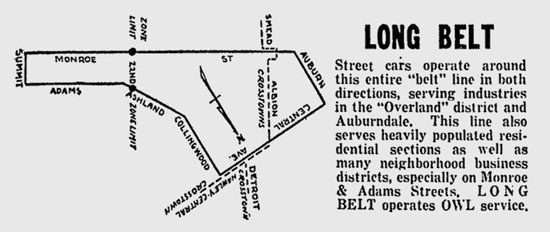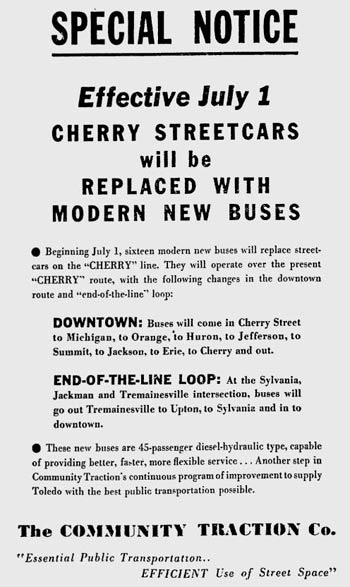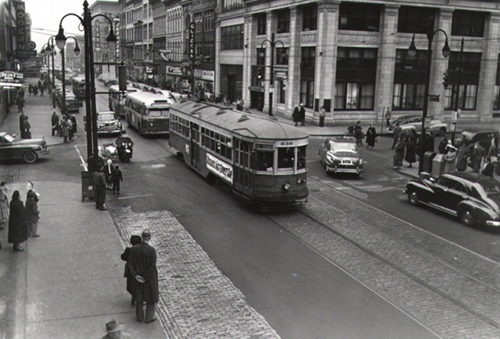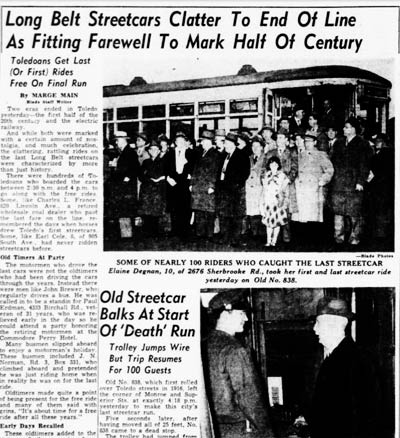
On the front page of the January 1, 1950 issue of the Toledo Sunday Blade, the big news was front and center: the Long Belt streetcar had made its last run on the last day of 1949, and the era of the streetcar had passed into history in Toledo.
And you couldn’t have written a more appropriate lead than The Blade’s Marge Main did: “Two eras ended in Toledo yesterday – the first half of the twentieth century and the electric railway.”
Tempted by free rides and the nostalgia of riding a streetcar one last time, hundreds turned out to ride the route on its last day, included many old-timers associated with the Community Traction Co. (CTC), Toledo’s mass transit provider for exactly fifty years from its birth on Feb. 1, 1921 until the Toledo Area Regional Transit Authority took over the operation of the money-losing company, and its fleet of red and yellow buses, on Feb. 1, 1971.

Formed from the forced merger of two competing transit companies, the CTC renewed a franchise with the city every ten years until the late 60s, when the company started losing money on a consistent basis. In 1963 and 1964, for example, the CTC ran a deficit of $100,000 a year, and began to look to the city for a solution (CTC’s profit and loss figures were monitored closely by the city and The Blade, which wrote about them frequently).
At their height, streetcars in Toledo carried 65 million passengers a year (that was in 1923) but after the end of World War II, the CTC followed the trend of many American cities in a shift to buses. One by one, the lines dwindled. The Cherry Street line was eliminated in 1948, leaving only the Long Belt. So the last run of the Long Belt was turned into an occasion.
Two cars made the last run starting at 4:18 p.m. that Sunday. Over 100 special guests of the company crammed onto the second car, No. 838, to make the last ride from Superior and Monroe to the car barns on W. Central Ave. (where the current TARTA bus garage stands today).

As the procession left downtown…
Hundreds of shoppers and store personnel lined downtown streets as the historic cavalcade rolled by amid clanging trolley bells, honking auto horns and the occasional singing by a few of the passengers. Amateur photographers gathered at street corners hoping to make pictures of the last car, but as the procession moved right through red lights, many of them has to shoot on the run.
At several Long Belt stops, would-be passengers stepped into the streets expecting one of the two cars to stop and take them aboard, One woman, her arms filled with packages, became rather exasperated when neither car stopped, frowned and stamped her foot. One of the passengers aboard No. 838 shouted to her, “Don’t worry lady – you’ve missed your last streetcar.”
The motorman on the last car, William G. Mammett, had to get out and put the trolley back on the wires about 25 feet into the last journey. It was his last ride as well: he was retiring after 47 years and to mark the occasion, “he eased back in the operator’s seat, lit a cigarette and took a smoke. He had brought to a close not only his own career as a streetcar motorman, but also a colorful and picturesque era in Toledo’s history.”
The CTC replaced the Long Belt with two new bus lines (Adams Street and Monroe Street) and rejiggered two other lines (Upton Avenue and Cherry Street) to compensate for the discontinuation of the Long Belt line.


Thank you for this bit of nostalgia. I was not around then but I like to see the pictures.
My late husband David Erbland rode it on it’s last ride. His Grandpa was John Jordanoff a civic leader at the time and owned a used Car lot in downtown Toledo.
Thank you for this my grandma was the First Lady streetcar driver
Thank you Jill,l was thinking the same thing.
I remember my mom taking me to a doctor across town on the streetcars
I rode the last day on car 807 at the age of 7 along with my sister and grandparents.